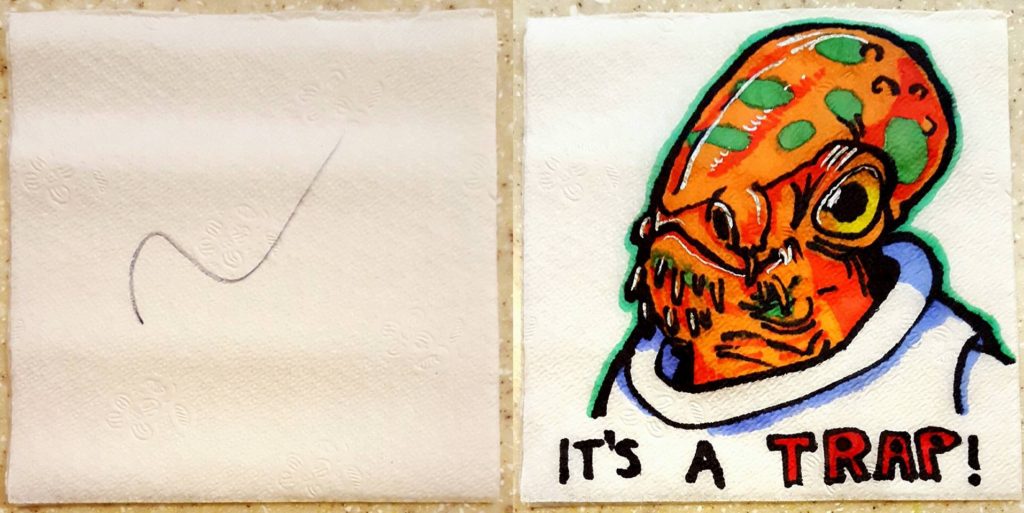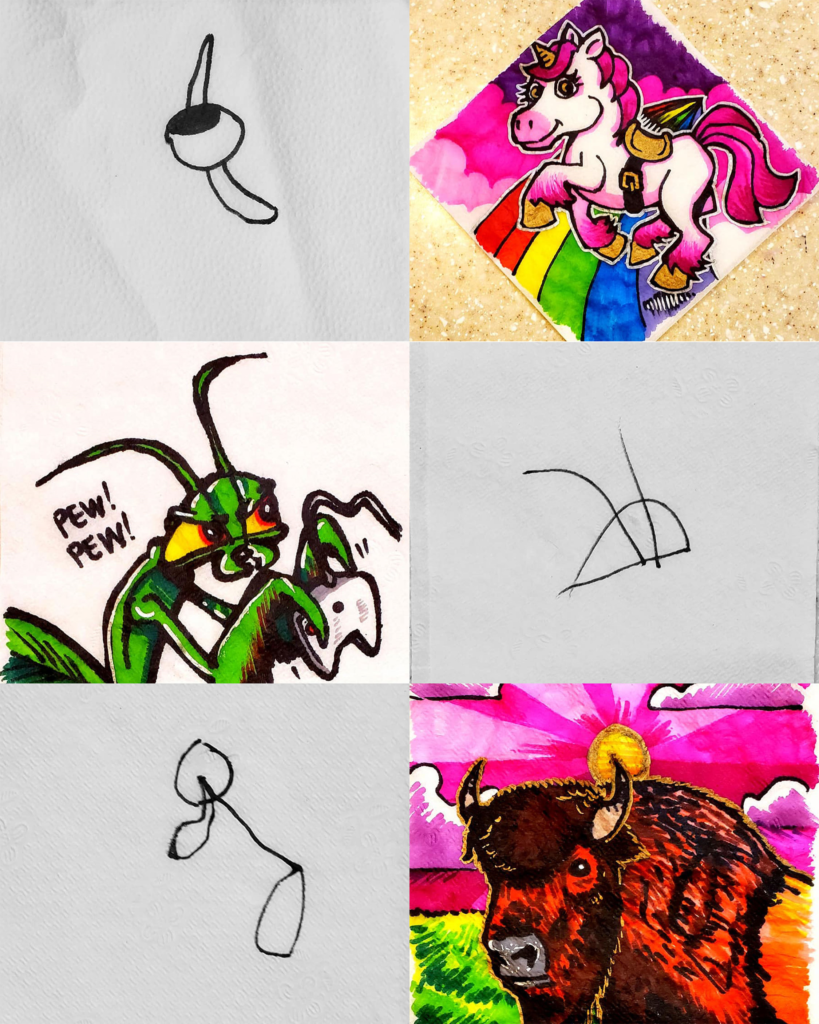RAPID CITY, SD- Professor Travis Kowalski starts most days with a squiggle.
For the past eight years, the South Dakota School of Mines & Technology math professor has carried on a family tradition started by his father, who would ask the young Travis to make a squiggle on a piece of paper. From that squiggle, his father would create a drawing. Often, Kowalski’s father would give him a squiggle and the two would sit together drawing.

Nowadays, Kowalski uses a napkin and markers in his “squiggle game,” and the recipients are his two daughters – Liliana, 13, and Maia, 9. Kowalski says he started the tradition when Liliana was entering kindergarten, hoping the lunch napkin art would make her transition to school easier.
Each evening or early in the morning, Kowalski encouraged his oldest to draw a squiggle on a napkin. The next morning, he turned the squiggle into colorful drawings and slipped it into her lunch box. Once Maia arrived, Kowalski began doing the same for her. “She expected it,” he says.

It’s not exactly what most people expect from a math professor at an engineering and science university. But Kowalski, a Ph.D. who currently serves as the interim head of the Department of Mathematics at SD Mines, says math and art co-mingle perfectly.
His drawings range from a buffalo against a bright pink sky (drawn May 6, 2019) to an astronaut in space (Jan. 24, 2019), to Kermit the Frog (Dec. 7, 2018), to the composer Bach at his harpsichord (May 14, 2018). Kowalski posts both the starting squiggle and the finished product on his Facebook and Instagram pages.

The two social media platforms are filled with vibrant, colorful drawings often accompanied by clever taglines – a bear holding up a paw and asking, “I would like some salmon, please” and a praying mantis playing a video game under the title, “Playing Mantis.”
Known on campus for his colorful Hawaiian shirts and clever math-related ties, Kowalski is the professor whose office walls are covered with unique visual art. He’s the kind of professor who sneaks his labradoodle Cauchy, named after French mathematician Augustin-Louis Cauchy, into class the last day of the semester to play out an obscure (to the general audience at least) mathematics joke. He’s the math teacher who so passionately talks about the subject that even the least math-minded people can’t help but get excited.

And he’s good at what he does in the classroom. So good that Kowalski was recently awarded the 2019 Burton W. Jones Award by the Mathematical Association of America. The award recognizes post-secondary level math instructors nationally who “foster student excitement about mathematics.”
“It’s cool and humbling to be part of that group,” he admits.
Donald Teets, a Ph.D. professor in the SD Mines math department, is a previous winner of the award and the person who nominated Kowalski. In his nomination, Teets writes, “He is, (in this writer’s opinion) the best teacher in a department devoted to teaching excellence.”
This is hardly the first recognition for Kowalski, Teets says. In 2014, Kowalski was awarded the Benard Ennenga Award, which honors one SD Mines faculty member each year for teaching excellence; and in 2017, he won the George Polya Award from the Math Association of America for his College Mathematics Journal article, “The Sine of a Single Degree.”
“His lecture based on ‘The Sine of a Single Degree’ is as good a mathematics lecture as you will ever see!” Teets wrote in his nomination.
Teets says the thing that makes Kowalski so good at this job is his enthusiasm, noting that students consistently rate him on classroom surveys as “the best math teacher I’ve ever had.” He’s “innovative,” constantly striving to engage his students and utilize technology into his teaching, Teets says. “Like Superman wears the big ‘S’ on his chest, Dr. Kowalski deserves a big ‘I’ for Innovator.”
As for Kowalski’s artistic talents, Teets is equally as effusive. “As a person who can barely draw recognizable stick figures, I am in awe of Travis’s artistic abilities. It’s a great complement to his extraordinary skills in mathematics!” he says.
Kowalski grew up in California, raised by a draftsman father and a “crafty” stepmother. “My dad drew all of the time,” Kowalski says. “That was the home I grew up in. You drew.”
In college at University of California, Riverside, Kowalski majored in art. To finish off an academic requirement, he enrolled in Calculus 2. A good student in high school, he had already taken an advanced placement Calculus 1 class. He was class valedictorian, but “I worked hard at it. I was not a prodigy,” he says with a laugh.
He still remembers the Riverside professor’s name who taught his first college math course – Albert Stralka. He “taught in a way I hadn’t seen before,” Kowalski says. “There were ideas behind the math.”
When he got an A in that class, the professor convinced him to take Calculus 3.
Next, the professor suggested he take topology, which is the study of geometric properties and spatial relations which are unaffected by the change of shape or size of figures. “It’s the geometry of shapes under change,” Kolwaski says. “That class blew my mind.”
The rest is history – after topology Kolwaski changed his major and embraced a love of mathematics. But he never left his art behind, and it’s important to understand that the two subjects go hand-in-hand, he says. “Half of mathematicians do what they do because they think it’s pretty,” he says of the geometry of math.
As a math professor at SD Mines, Kolwaski admits that “I still like to sit and draw things, but I don’t have as much time anymore,” he says.
That’s where his morning squiggle drawings come in.
Each one of Kowalski’s squiggles for his daughters takes about 15 to 30 minutes from start to finish. “The first part is to see something,” he says. He spins the napkin around, looking at the squiggle until he “sees” the picture that will emerge.
Mia tends to draw extremely elaborate squiggles, sometimes lobbying for a specific outcome – for instance a unicorn. Other times, his daughters will bring home requests from friends for specific drawings.
Liliana has saved all her napkins over the years, storing them in a plastic container in her room. That made it a little easier for Kowalski when she came to him recently to say, “What with my school schedule being so busy and my lunch break so short and closet so full of the ones you’ve already made me – which I love, thank you – I just don’t think you need to make me lunch napkins anymore.” Kowalski playfully posted her words on social media with an image from Boromir’s death from “Fellowship of the Rings” with arrows sticking from his heart.
Kowalski says his older daughter relented, most likely after an intervention from his wife, and is continuing to play the squiggle game. He’s glad, hoping that both of his daughters will always remember the squiggle game and maybe even carry it on with their own families one day.
“It’s definitely a great memory about my dad,” he says. “Hopefully it will be the same for them.” For the Silo, Lynn Taylor Rick.
